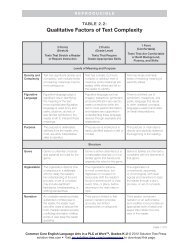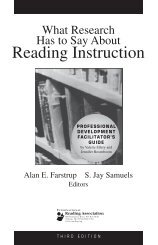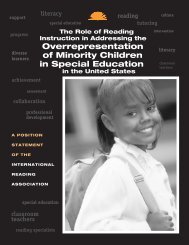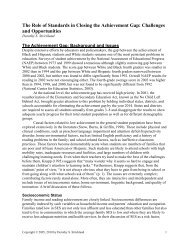Global Education Digest 2012 - International Reading Association
Global Education Digest 2012 - International Reading Association
Global Education Digest 2012 - International Reading Association
You also want an ePaper? Increase the reach of your titles
YUMPU automatically turns print PDFs into web optimized ePapers that Google loves.
OPPORTUNITIES LOST: THE IMPACT OF GRADE REPETITION AND EARLY SCHOOL LEAVING<br />
BOX 5. New OECD estimates for the costs of grade repetition<br />
As part of the PISA 2009 background questionnaire, a number of 15-year-old students reported having<br />
repeated a grade at least once in primary, lower secondary or upper secondary education. OECD has<br />
introduced new estimates for the cost of grade repetition by adding up direct costs and opportunity<br />
costs.<br />
The direct costs are the costs for education systems to provide one additional year of education. The<br />
opportunity costs are the costs of delaying students’ entry into the labour market by one additional<br />
year. Two assumptions underlie the estimation of opportunity costs: i) repeaters attain at most the<br />
lower secondary level (i.e. using annual labour costs for ISCED levels 0 to 2 for 25- to 64-year-olds and<br />
the unemployment rate for “below upper secondary education”); and ii) repeaters attain the national<br />
average education level (i.e. using the average annual labour costs for 25- to 64-year-olds and the<br />
unemployment rate for “all levels of education”).<br />
Estimation results indicate that the United States, Germany and Brazil have the three highest annual<br />
costs for grade repetition. In these countries, the total annual cost for grade repetition is estimated at<br />
20.8, 6.9 and 6.8 trillion purchase power parities in U.S. dollars (PPP US$) respectively. This represents<br />
about 4% of total expenditure on primary and secondary education in the United States and about 9%<br />
of costs in Brazil and Germany.<br />
This estimation approach does not address the benefits of grade repetition or the costs of not having<br />
grade repetition. For example, by repeating grades, students’ productivity and readiness for the labour<br />
market might be improved. <strong>Education</strong> systems might have to implement relevant policies and invest<br />
resources, such as extra tuition and subsidies for at-risk students, in order to avoid grade repetition,<br />
but these costs are not incorporated into this estimation. In addition, these cost estimates are based<br />
on the assumption that the most recent data on labour costs and unemployment rates will remain<br />
stable over time.<br />
Source: OECD (2011).<br />
graduate, it is also possible to assess the internal<br />
efficiency of the education system and compute<br />
costs associated with the educational resources<br />
consumed by repetition and early school leaving<br />
(Cuadra and Fredriksen, 1992; UNESCO, 1980,<br />
1998). Calculating indirect costs involves taking a<br />
broader view, which includes potential human capital<br />
development, economic returns and growth that<br />
might be delayed or missed due to grade repetition<br />
or early school leaving (Belfield, 2008; OECD, 2011).<br />
Measures of school life expectancy net of repetition<br />
indicate the average number of grades that a child<br />
is likely to attain in school and help to inform about<br />
the inefficiency of grade repetition from an economic<br />
point of view. In a number of countries that reported<br />
data, the years spent repeating grades make up a<br />
substantial proportion of the output of education<br />
systems (see Figure 24). Repetition can result in<br />
two to three additional years in Burundi and Togo,<br />
and almost one additional year or more in a range of<br />
other countries, primarily in sub-Saharan Africa, but<br />
also in Algeria, Morocco, Timor-Leste, Tunisia, Lao<br />
People’s Democratic Republic and Uruguay. The years<br />
spent repeating typically occur in primary education,<br />
although grade repetition in lower secondary<br />
education makes up more one-than half of the<br />
additional years in Algeria, Tunisia and Uruguay.<br />
It is important to note that each year of real additional<br />
schooling (not due to repetition) could, on average,<br />
increase individual earnings by 10% and lift annual<br />
GDP growth globally by 0.37% (UNESCO, 2010). In<br />
this regard, if resources spent on repeating a grade<br />
were instead spent on enrolling new entrants into<br />
school without reducing the quality of education,<br />
annual GDP in countries like Burundi, Madagascar<br />
and Malawi could grow potentially by 1.3%, 0.7%<br />
and 0.6% respectively.<br />
5.3 POLICY OPTIONS FOR REDUCING<br />
REPETITION AND EARLY SCHOOL<br />
LEAVING<br />
It is difficult to design comprehensive policies to<br />
reduce repetition, early school leaving and low<br />
55

















